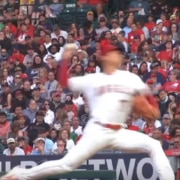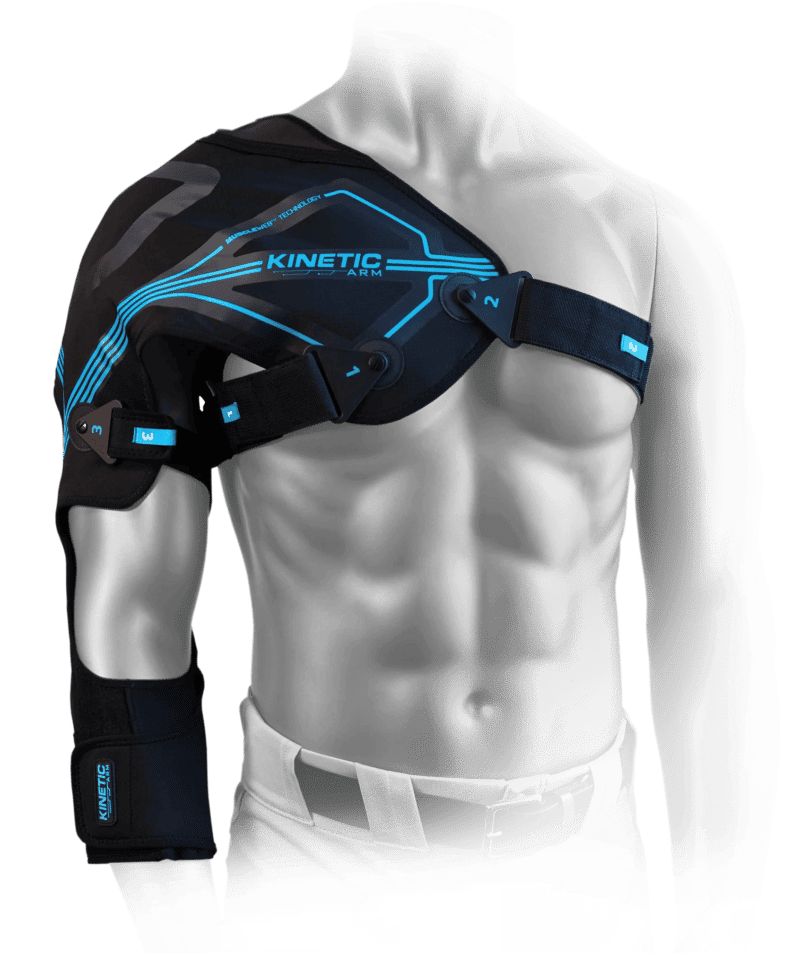Arm Protective Sleeves For Baseball Youth Pitchers Safe? | Can Kinetic Arm Help Provide Treatment To AVOID Tommy John Surgery OR Little League Shoulder?

Discover whether arm protective sleeves are safe for baseball youth pitchers, and learn whether the Kinetic Arm can help provide early “treatment” to AVOID Tommy John surgery AND little league shoulder. Real time data suggests the Kinetic Arm reduces elbow stress by 30%!
Protective Arm Sleeves for Kids: Overprotective Parenting or a Game-Changing Innovation?
Hey there, fellow baseball or softball pitching parents! Before you roll your eyes thinking this is just another article about kids and their fancy gear (aka “drip”), stick with me. I promise there’s a method to the madness, sprinkled with a dash of nostalgia and good old baseball trivia.
A Brief History of Baseball and Protective Gear
Ever watched those classic baseball clips? Players in baggy uniforms, and almost no protective gear. Catchers not wearing a mask. Hitters not wearing a helmet. Grown men playing infield not wearing a cup. Yep, times have changed!
Evolution of Safety Measures
From helmets to shin guards, safety gear has grown up with the sport. What started as protective essentials have now become status symbols, with players even personalizing their gear. But, is it all just about looking cool?
Not Just a Fashion Statement
The past decades have seen a surge in research dedicated to athlete safety. These aren’t just aesthetic upgrades; they’re backed by some serious science.
Before getting started, here are a couple helpful articles:
- American Sports Medicine Institute – Position Statement for Adolescent Baseball Pitchers, and
- PubMed – Sport Specialization and Overuse Injuries in Adolescent Throwing Athletes: A Narrative Review.
The Dreaded Tommy John Injury: A Nightmare for Young Pitchers
Tommy John surgery (ulnar collateral ligament reconstruction) has seen a notable uptick in the youth demographic, particularly in young baseball pitchers. Interpreting the available data up until January of 2022, here are the top 5 factors I’d identify for this increase:
- Increased Specialization at a Young Age: Many young athletes nowadays focus on a single sport year-round, rather than playing multiple sports across different seasons. This constant repetition, especially in baseball pitching, places immense strain on the elbow, leading to wear and tear. Not having an off-season deprives the arm of much-needed rest.
- Overuse: Linked closely with specialization, overuse is rampant among young pitchers. Whether it’s pitching for multiple teams, participating in showcases, or not adhering to pitch count guidelines, constant pitching without proper rest intervals puts significant strain on the developing ligaments of young arms.
- Improper Mechanics: Proper pitching mechanics are crucial in distributing the stresses of the throw across the body. Improper mechanics, especially in young pitchers still mastering their technique, can place undue stress on the elbow. Consistent repetition of poor mechanics can accelerate the wear on the UCL.
- Early Velocity Training: There’s been a trend of emphasizing pitch speed at earlier ages. Young pitchers, in their eagerness to hit higher velocities, might adopt training methods and pitching loads that their bodies aren’t yet ready to handle, leading to increased risk. Versus diving into Perry Husband’s Effective Velocity, which is working much smarter, not harder.
- Lack of Proper Conditioning and Physical Training: While youth athletes may train often, they might not train right. Proper conditioning, flexibility exercises, and strength training specific to pitchers can protect the arm and elbow. The absence or inadequate focus on such conditioning can leave young pitchers vulnerable.
While these are broad factors, it’s essential to remember that each athlete is unique. There could be individual factors (like these young athletes are GROWING!!), or a combination of the above, leading to an injury. Proper education for coaches, parents, and players on recognizing and addressing these issues is vital to curbing this growing trend.
Speaking of growing trends…
Biomechanics Insight: Understanding “Little League” Shoulder
In the realm of biomechanics, the precise interaction of forces and motion plays a pivotal role in an athlete’s performance and well being. “Little League Shoulder” exemplifies the consequences of mismanaged biomechanical forces in young pitchers.
At its core, “Little League Shoulder” stems from an imbalance: the repetitive and forceful actions of overhand pitching exert significant stress on the proximal humerus’s growth plate (the physis). In the young athlete, this growth plate is still maturing and is more vulnerable than the surrounding ligaments and muscles.
Biomechanical Perspective
Biomechanically speaking, every pitch applies torque to the shoulder. In a mature arm, the muscles, tendons, and ligaments distribute this torque effectively, minimizing the risk. However, in the developing arm of an adolescent, continuous pitching without adequate rest can overload the growth plate. The result? Micro-traumas, inflammation, and a widened growth plate, manifesting as pain and swelling.
Age and Vulnerability
Age plays a crucial factor. Between 11 and 16, as youths undergo growth spurts, their skeletal structures are rapidly evolving, making the growth plates particularly susceptible.
In summary, “Little League Shoulder” is a biomechanical repercussion of overuse in a still-maturing musculoskeletal system. Proper rest, conditioning, and biomechanically-informed training are paramount in preventing this injury.
If you’re interested in the Kinetic Arm, then here’s how to get 5% OFF your purchase, use Discount Code: GET5OFF at checkout.
Protective Arm Sleeves: Not Just For Show (“Drip”)
Enter the superhero of our story: the protective arm sleeve.
The Biomechanics Behind the Sleeve
A select few of these sleeves aren’t just fabric tubes. They support muscles and joints, improve blood flow, and maintain a steady arm temperature. It’s like giving your arm a cozy, protective hug.
Real Benefits or Just Hype?
Reduced muscle soreness, better performance, and possibly fewer injuries? Sounds like a home run to me! Maybe. You need to be using the right sleeve.
Naysayers’ Corner: Arguments Against the Protective Arm Sleeve
But wait! Every superhero has its critics.
The “Tough It Out” Mentality
Some believe these protective arm sleeves make kids soft. “Back in my day…” – sounds familiar, right? While toughness is admirable in football, safety is paramount when it comes to growing healthy youth arms.
Concerns About Over-reliance
It’s valid to worry kids might become too dependent on a protective arm sleeve – like a crutch. But, it’s all about balance, right? Teach them to use but not overuse.
Making An Informed Decision For Your Young Athlete
Every child is unique. While protective arm sleeves offer undeniable benefits, it’s essential to ensure they’re used as a tool, not a crutch.
Conclusion: My Two Cents as a Biomechanics Buff
Whether you’re team protective arm sleeve or not, we can agree on one thing: kids’ arm safety is a priority. If a piece of gear can help, why not give it a shot? After all, isn’t it better to be safe than sorry (and stylish to boot)?
Consider this…
Introducing: The Kinetic Arm™ Dynamic Arm Stabilizer
In the vast landscape of sports gear, a few revolutionary products emerge that redefine standards. The Kinetic Arm™ is one such innovation, designed not just to protect but to elevate.
The True Cost of Not Protecting Your Arm
Consider this: A single misstep or overuse in your athletic journey could lead you down the path of Tommy John surgery. The rehab, the time away from the game, the potential long-term impact on performance — it’s a journey no athlete wishes to undertake. Yet, the increasing demands on pitchers, especially the young and ambitious, make this a looming threat.
Why Settle for Less When Excellence Awaits?
With the Kinetic Arm™, you’re not merely wearing a protective sleeve. You’re investing in the future of your athletic prowess. It’s more than fabric; it’s an assurance.
Step Beyond Tradition
Gone are the days when protective gear was cumbersome and restrictive. The Kinetic Arm™ is designed to be an extension of you. It moves as you move, ensuring not just safety but enhancing every throw, every swing.
MuscleWeb™ Technology: A Revolution in Athletic Support
This isn’t just a catchy term. The MuscleWeb™ Technology is the culmination of years of research. It aligns seamlessly with your muscles, offering unparalleled support without compromising on freedom of movement. It’s as if your arm finds its natural rhythm, each time, every time.
Benefits That Speak Volumes:
- Evidence-based Excellence: Our claims aren’t hollow. We stand by data and research, which underscores every feature of the Kinetic Arm™.
- Reduction in Elbow Stress: With a proven 30% reduction in elbow torque and stress, this isn’t just a protective gear—it’s a rejuvenating experience for your arm. Think of it as preventative care, ensuring you remain at the top of your game for longer.
- Multifaceted Advantages: Wearing the Kinetic Arm™ translates to enhanced conditioning and speed that sets you apart. More importantly, it’s a shield against potential injuries, making sure the game’s setbacks don’t set you back.
In the end, the question isn’t whether you need the Kinetic Arm™. It’s whether you’re ready to commit to the best for your athletic journey. The game is evolving. Make sure you’re equipped to evolve with it. Embrace the Kinetic Arm™ and let every move, every pitch, every swing be a testament to your dedication to excellence. The next move is yours.
If you’re interested in the Kinetic Arm, then here’s how to get 5% OFF your purchase, use Discount Code: GET5OFF at checkout.
FAQs:
- Do arm sleeves actually prevent injuries? While they can reduce the risk by improving blood flow and muscle support, they aren’t a magic shield. Proper training and rest are equally important. See the Tommy John section above.
- Aren’t kids too young for such specialized gear? It’s never too early to prioritize safety, especially when the gear can enhance performance too.
- How do I choose the right sleeve for my child? Focus on fit, material quality, and ensure it’s designed for baseball-specific movements.
- Won’t kids become too reliant on gear? It’s about educating them. Gear is a tool, not a replacement for skill and training.
- How often should the sleeve be washed or replaced? Regular washing after intense sessions is essential. Replace it when wear and tear become evident or if it loses elasticity.
- Best Youth Baseball Hitting Program to Boost Rotational Power Fast—Trusted by MLB’s Rajai Davis & Built on the Catapult Loading System - June 22, 2025
- The #1 Arm Care Program for Youth Baseball: Why Top Travel Coaches Trust Jaeger’s J-Bands & Long Toss Routine to Prevent Injury Fast - June 3, 2025
- Are Baseball Hitting Lessons Worth It in 2025? Fix Your Kid’s Swing Fast With Pro-Approved Drills (Before You Waste Another $60) - May 29, 2025





